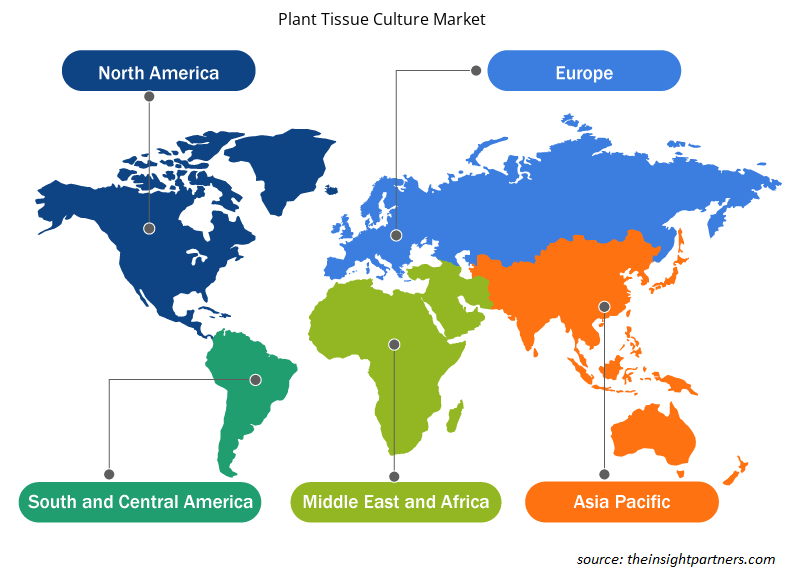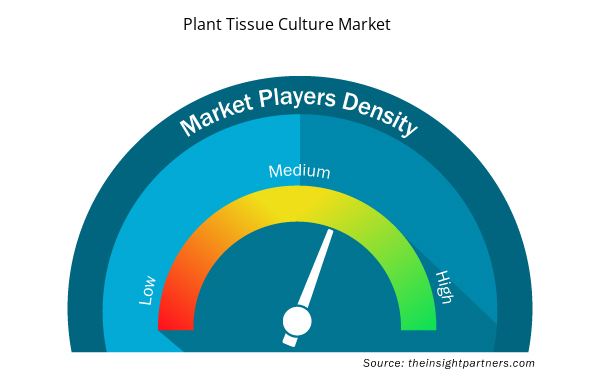[研究报告] 2021年植物组织培养市场价值为 4.7588 亿美元;预计 2022 年至 2028 年的复合年增长率为 8.9%。
植物组织培养是一套在已知成分的培养基中,在体外条件下培养植物细胞、组织或器官的技术。植物的克隆可以通过微繁殖产生。组织培养能够生产无病、高质量的种植材料。它还有助于植物快速均匀地生长。对转基因植物的需求不断增加和花卉栽培的普及是推动市场增长的关键因素。然而,组织培养程序的高成本阻碍了市场的发展。
植物组织培养市场是根据技术、应用、材料和地理进行分析的。该报告对植物组织培养市场提供了见解和深入分析,强调了市场趋势、技术进步和市场动态等各种参数,以及主要市场参与者的竞争格局分析。
定制此报告以满足您的需求
您可以免费定制任何报告,包括本报告的部分内容、国家级分析、Excel 数据包,以及为初创企业和大学提供优惠和折扣
- 获取此报告的关键市场趋势。这个免费样品将包括数据分析,从市场趋势到估计和预测。
市场洞察
转基因植物需求不断增长推动植物组织培养市场增长
转基因植物是指利用基因工程技术修改植物的 DNA,从而为植物引入自然界中不会产生的新特性的植物。这些转基因植物是在实验室中利用基因工程技术通过改变基因组成而产生的,通常是在植物的基因组中添加一个或多个基因。转基因植物的主要开发目的是提供必要的营养物质,满足全球的粮食需求。
数百万人营养不良,这种情况在发展中国家和欠发达国家更为普遍。根据世界卫生组织 (WHO) 的数据,2019 年,约有 4.62 亿人体重不足。根据联合国儿童基金会的数据,五岁以下儿童死亡人数中近一半归因于营养不良。此外,2020 年,约有 4540 万五岁以下儿童消瘦,其中约 1360 万严重消瘦。根据全球变化数据实验室的数据,2019 年,世界人口中有 8.9% 营养不良。营养不良的人是指卡路里摄入量低于最低能量需求的人。研究人员正致力于开发提供所需卡路里以满足这些卡路里需求的转基因植物。对转基因植物的需求正在推动植物组织培养市场的增长。
基于类型的洞察
根据类型,植物组织培养市场分为仪器、培养基和试剂以及耗材。仪器部分在 2021 年占据了最大的市场份额。然而,预计耗材部分在预测期内的复合年增长率最高。植物组织培养中使用的仪器包括冰箱、蒸馏设备、层流空气系统、称重天平、孵化器、离心机、灭菌器等。
基于应用的洞察
根据应用,植物组织培养市场细分为植物研究、农业、林业和技术级以及其他。农业部门在 2021 年占据了最大的市场份额。然而,植物研究部门预计将在 2022-2028 年期间实现最高的复合年增长率。
基于最终用户的洞察
根据最终用户,植物组织培养市场分为温室、田间和实验室。田间部分在 2021 年占据了最大的市场份额。此外,预计该部分市场在 2022-2028 年期间的复合年增长率为 9.2%。
在许多国家,COVID-19 限制了人员跨境流动,封锁导致农业部门出现劳动力短缺,特别是那些劳动力需求季节性高峰或劳动密集型生产的部门。例如,欧盟内部的旅行禁令以及申根区的封锁,导致许多欧洲国家水果和蔬菜部门的可用劳动力大幅减少。劳动力短缺导致生产损失和市场短缺。COVID-19 紧急情况损害了园艺产品的物流、配送和供应链。这导致农产品供应链中断,造成粮食不安全,结果,很大一部分人口难以以合理的价格获得新鲜食品。上述因素对整个植物组织培养产业产生了严重影响。
植物组织培养市场区域洞察
Insight Partners 的分析师已详细解释了预测期内影响植物组织培养市场的区域趋势和因素。本节还讨论了北美、欧洲、亚太地区、中东和非洲以及南美和中美洲的植物组织培养市场细分和地理位置。

- 获取植物组织培养市场的区域特定数据
植物组织培养市场报告范围
| 报告属性 | 细节 |
|---|---|
| 2021 年市场规模 | 4.7588亿美元 |
| 2028 年市场规模 | 8.6347亿美元 |
| 全球复合年增长率(2021 - 2028) | 8.9% |
| 史料 | 2019-2020 |
| 预测期 | 2022-2028 |
| 涵盖的领域 | 按类型
|
| 覆盖地区和国家 | 北美
|
| 市场领导者和主要公司简介 |
|
植物组织培养市场参与者密度:了解其对业务动态的影响
植物组织培养市场正在快速增长,这得益于终端用户需求的不断增长,而这些需求又源于消费者偏好的不断变化、技术进步以及对产品优势的认识不断提高等因素。随着需求的增加,企业正在扩大其产品范围,进行创新以满足消费者的需求,并利用新兴趋势,从而进一步推动市场增长。
市场参与者密度是指在特定市场或行业内运营的企业或公司的分布情况。它表明在给定市场空间中,相对于其规模或总市场价值,有多少竞争对手(市场参与者)存在。
在植物组织培养市场运营的主要公司有:
- 世格拉国际公司
- JRT 苗圃公司
- 托马斯科学有限责任公司
- 西格玛奥德里奇有限公司
- HiMedia 实验室私人有限公司
免责声明:上面列出的公司没有按照任何特定顺序排列。

- 了解植物组织培养市场顶级关键参与者概况
2022 年,北美占据植物组织培养市场的最大份额。该地区市场的增长归因于组织培养领域研发活动的增加。此外,预计亚太地区在预测期内的复合年增长率最快。中国、日本和印度是该地区植物组织培养市场的主要贡献者。亚太地区的市场增长归因于政府对促进基于组织培养的研究的投资增加、先进技术的采用规模不断扩大以及支持组织培养实验室的基础设施的改善。
根据地域划分,植物组织培养市场分为北美洲(美国、加拿大和墨西哥)、欧洲(英国、德国、法国、意大利、西班牙和欧洲其他地区)、亚太地区(中国、日本、印度、韩国、澳大利亚、亚太其他地区)、中东和非洲(阿联酋、沙特阿拉伯、非洲和中东和非洲其他地区)以及南美洲和中美洲(巴西、阿根廷和南美洲和中美洲其他地区)。
公司简介
- 世格拉国际公司
- JRT 苗圃公司
- 托马斯科学有限责任公司
- 西格玛奥德里奇有限公司
- HiMedia 实验室私人有限公司
- 凯森实验室公司
- Alpha 实验室有限公司
- 碧迪公司
- AL-Rajhi 组织培养实验室
- Al Wathba Marionnet 有限责任公司
- 历史分析(2 年)、基准年、预测(7 年)及复合年增长率
- PEST 和 SWOT 分析
- 市场规模价值/数量 - 全球、区域、国家
- 行业和竞争格局
- Excel 数据集



Report Coverage
Revenue forecast, Company Analysis, Industry landscape, Growth factors, and Trends

Segment Covered
This text is related
to segments covered.

Regional Scope
North America, Europe, Asia Pacific, Middle East & Africa, South & Central America

Country Scope
This text is related
to country scope.
常见问题
Plant tissue culture is a set of techniques used to grow plant cells, tissues or organs under invitro conditions on a culture medium of known composition. Through micropropagation, clones of plants can be produced. Tissue culture is an important technology and enables production of high quality, disease-free planting material and the speedy production of uniform plants.
The increasing demand for transgenic plants, and growing demand for floriculture are the key driving factors behind the market development.
Based on type, instruments segment took the forefront lead in the worldwide market by accounting largest share in 2021 and is expected to continue to do so till the forecast period.
Global plant tissue culture market is segmented by region into North America, Europe, Asia Pacific, Middle East & Africa, and South & Central America. In North America, the U.S. is the largest market for plant tissue culture market. Growing investment for tissue culture techniques, well established scientific infrastructure and rising focus of market players are key factors responsible for market growth in the region.
Segra International Corp, JRT Nurseries Inc, Thomas Scientific LLC, Sigma-Aldrich Co LLC, HiMedia Laboratories Pvt Ltd, Caisson Labs Inc, Alpha Laboratories Ltd, Becton, Dickinson and Co., AL-Rajhi Tissue Culture Lab., Al Wathba Marionnet LLC. are among the leading companies operating in the plant tissue culture market.
Trends and growth analysis reports related to Life Sciences : READ MORE..
The List of Companies - Plant Tissue Culture Market
- Segra International Corp
- JRT Nurseries Inc
- Thomas Scientific LLC
- Sigma-Aldrich Co LLC
- HiMedia Laboratories Pvt Ltd
- Caisson Labs Inc
- Alpha Laboratories Ltd
- Becton, Dickinson and Co
- AL-Rajhi Tissue Culture Lab
- Al Wathba Marionnet LLC
The Insight Partners performs research in 4 major stages: Data Collection & Secondary Research, Primary Research, Data Analysis and Data Triangulation & Final Review.
- Data Collection and Secondary Research:
As a market research and consulting firm operating from a decade, we have published and advised several client across the globe. First step for any study will start with an assessment of currently available data and insights from existing reports. Further, historical and current market information is collected from Investor Presentations, Annual Reports, SEC Filings, etc., and other information related to company’s performance and market positioning are gathered from Paid Databases (Factiva, Hoovers, and Reuters) and various other publications available in public domain.
Several associations trade associates, technical forums, institutes, societies and organization are accessed to gain technical as well as market related insights through their publications such as research papers, blogs and press releases related to the studies are referred to get cues about the market. Further, white papers, journals, magazines, and other news articles published in last 3 years are scrutinized and analyzed to understand the current market trends.
- Primary Research:
The primarily interview analysis comprise of data obtained from industry participants interview and answers to survey questions gathered by in-house primary team.
For primary research, interviews are conducted with industry experts/CEOs/Marketing Managers/VPs/Subject Matter Experts from both demand and supply side to get a 360-degree view of the market. The primary team conducts several interviews based on the complexity of the markets to understand the various market trends and dynamics which makes research more credible and precise.
A typical research interview fulfils the following functions:
- Provides first-hand information on the market size, market trends, growth trends, competitive landscape, and outlook
- Validates and strengthens in-house secondary research findings
- Develops the analysis team’s expertise and market understanding
Primary research involves email interactions and telephone interviews for each market, category, segment, and sub-segment across geographies. The participants who typically take part in such a process include, but are not limited to:
- Industry participants: VPs, business development managers, market intelligence managers and national sales managers
- Outside experts: Valuation experts, research analysts and key opinion leaders specializing in the electronics and semiconductor industry.
Below is the breakup of our primary respondents by company, designation, and region:

Once we receive the confirmation from primary research sources or primary respondents, we finalize the base year market estimation and forecast the data as per the macroeconomic and microeconomic factors assessed during data collection.
- Data Analysis:
Once data is validated through both secondary as well as primary respondents, we finalize the market estimations by hypothesis formulation and factor analysis at regional and country level.
- Macro-Economic Factor Analysis:
We analyse macroeconomic indicators such the gross domestic product (GDP), increase in the demand for goods and services across industries, technological advancement, regional economic growth, governmental policies, the influence of COVID-19, PEST analysis, and other aspects. This analysis aids in setting benchmarks for various nations/regions and approximating market splits. Additionally, the general trend of the aforementioned components aid in determining the market's development possibilities.
- Country Level Data:
Various factors that are especially aligned to the country are taken into account to determine the market size for a certain area and country, including the presence of vendors, such as headquarters and offices, the country's GDP, demand patterns, and industry growth. To comprehend the market dynamics for the nation, a number of growth variables, inhibitors, application areas, and current market trends are researched. The aforementioned elements aid in determining the country's overall market's growth potential.
- Company Profile:
The “Table of Contents” is formulated by listing and analyzing more than 25 - 30 companies operating in the market ecosystem across geographies. However, we profile only 10 companies as a standard practice in our syndicate reports. These 10 companies comprise leading, emerging, and regional players. Nonetheless, our analysis is not restricted to the 10 listed companies, we also analyze other companies present in the market to develop a holistic view and understand the prevailing trends. The “Company Profiles” section in the report covers key facts, business description, products & services, financial information, SWOT analysis, and key developments. The financial information presented is extracted from the annual reports and official documents of the publicly listed companies. Upon collecting the information for the sections of respective companies, we verify them via various primary sources and then compile the data in respective company profiles. The company level information helps us in deriving the base number as well as in forecasting the market size.
- Developing Base Number:
Aggregation of sales statistics (2020-2022) and macro-economic factor, and other secondary and primary research insights are utilized to arrive at base number and related market shares for 2022. The data gaps are identified in this step and relevant market data is analyzed, collected from paid primary interviews or databases. On finalizing the base year market size, forecasts are developed on the basis of macro-economic, industry and market growth factors and company level analysis.
- Data Triangulation and Final Review:
The market findings and base year market size calculations are validated from supply as well as demand side. Demand side validations are based on macro-economic factor analysis and benchmarks for respective regions and countries. In case of supply side validations, revenues of major companies are estimated (in case not available) based on industry benchmark, approximate number of employees, product portfolio, and primary interviews revenues are gathered. Further revenue from target product/service segment is assessed to avoid overshooting of market statistics. In case of heavy deviations between supply and demand side values, all thes steps are repeated to achieve synchronization.
We follow an iterative model, wherein we share our research findings with Subject Matter Experts (SME’s) and Key Opinion Leaders (KOLs) until consensus view of the market is not formulated – this model negates any drastic deviation in the opinions of experts. Only validated and universally acceptable research findings are quoted in our reports.
We have important check points that we use to validate our research findings – which we call – data triangulation, where we validate the information, we generate from secondary sources with primary interviews and then we re-validate with our internal data bases and Subject matter experts. This comprehensive model enables us to deliver high quality, reliable data in shortest possible time.


 获取此报告的免费样本
获取此报告的免费样本